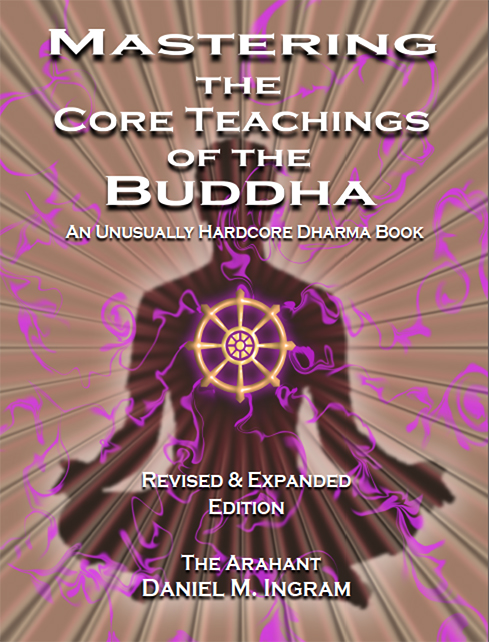The No-Thought Models
← The Psychological Models | The God Models →
Speaking of problematic models, we have the no-thought models. These are models that tend to focus on something different happening with thoughts in those who are awakened, rather than simply seeing through the thought patterns that create a sense of a centerpoint or special, permanent, separate, independently existing self. These idealized models include not thinking certain thoughts, such as enlightened beings being unable to have the thoughts “I”, or “I am”, or them not thinking at all and thus stopping the process of thought, or some other modification to thoughts, such as always thinking good thoughts, whatever those are.
Do the minds of progressively awakened people generally get quieter? Yes. May they experience greater periods of time when inner talk seems to be doing very little? Yes. May they come to a completely different perceptual relationship to thoughts in general? Yes. Does anyone who is still alive eliminate all categories of experience that are mental and might be classified as thoughts? No.
I got an email awhile ago from a nice engineer who said basically: “I did some Taoist practices, got enlightened, and now am incapable of thinking any thoughts or visualizing, yet I seem to function normally. What do you think of this?” I put a lot of thought into my response, and so am including it here, in slightly edited and revised form:
“One of my teachers, the late Bill Hamilton, used to talk about how people’s conceptions of what was supposed to happen would have some influence on subsequent events, but with some question remaining over what that influence might be. We used to discuss this often, with possibilities including:
1) People with different models of awakening might achieve different results. (The more I practice and get to know people’s practices well, the more I realize there are some real individual variations on some of the general themes. That said, there are also commonalities to how most human brains function.)
2) People with different models might achieve the same thing but describe it differently. (I like this one more than the first.)
3) Some combination of 1) and 2).
4) People might fail to achieve results but be scripted to report or believe that they had achieved something in line with their own working model. This is a common occurrence, one that I have observed in myself more times than I can count and also in the practice of many other fellow dharma adventurers. Bill would often mention people’s ability to self-hypnotize into semi-fixed states of delusion. He had a long run of hanging out in scary cult-like situations with psychopathic teachers and friends and got to observe this firsthand in himself and others: see his book Saints & Psychopaths for more on this.
5) People with different models and techniques might have very different experiences of the path along its way: this is clearly true in some aspects, and yet the universal aspects of the path continue to impress me with their consistency and reproducibility regardless of tradition.
6) Other possibilities we haven’t considered, in the style of Donald Rumsfeld’s famous “unknown unknowns”.
The “no-thought” question is an interesting one. It is commonly used in some traditions as being the goal, these including some strains and descriptions of Hindu Vedanta, multiple non-aligned traditions, and others. Zen and some Thai teachers sometimes toy with the idea on its periphery. As to Taoism: I did a bunch of reading of the old Taoist masters some years ago, but I wouldn’t consider myself an expert on its current practice or dogma.
Buddhism does not generally consider not thinking or not being able to visualize among its goals, which brings us to the points mentioned above. For instance, the Buddha often says things in the old texts like, “It occurred to me that I should wander by stages to [such and such a place].” Or, “This spontaneous stanza, never heard before, occurred to me.” These obviously are thoughts. Furthermore, if we take the old texts as a reference, all the enlightened disciples of the Buddha and the Buddha himself were described as thinking thoughts, and furthermore, as expressing them in speech, which evidences preceding thoughts and intentions. Further, many of the Buddha’s disciples could visualize, as could the Buddha, and you can’t be a tantric master without some strong visualization abilities.
Even further, the notion that one can write an email or do engineering, which inherently involves abstraction (mathematics) and other concepts being converted into actuality, or even speak and have it not involve thought, is one that I think is merely a conceptual understanding itself and thus an arbitrary designation. As intentions fall into the realm of thought, and all physical actions are preceded by intentions by the fixed mechanics of the system, the notion that action can occur without thought falls into the same camp. This also applies to all such things as memory, which you clearly demonstrate, as this inherently must involve thought by definition (with caveats as above).
Given those assumptions, the question I ask is: have you simply stopped calling those processes “thought” to fit with an arbitrary and dogmatic model? Have you perhaps forced yourself to stop noticing that mental processes occur, as you believed that was supposed to happen? Maybe you have achieved something real and because of your preconceptions choose to describe it through that terminological filter, or have achieved something completely different from those that is not on my radar screen for whatever reason, possibilities including my own delusion or lack of experience, as self-doubt and reasonable skepticism clearly have a place in all such discussions.
The terminology that I am familiar with involves seeing thoughts as they are, thus having them be just a very small and transient part of the natural, causal field of experience. However, please realize that, since thoughts can only be experienced as aspects of the other five sense doors, then labeling thought as thought is also just an abstraction and just as arbitrary as is labeling the other five sense doors as such. These are simply convenient designations (thoughts) for the sake of discussion.
When one notices that all things that simply arise causally, including those sensations that may or may not be designated as thoughts, are empty of a self, as they are and always have been, with no separate or independent observer or controller or doer that is not just a part of the field of experience or manifestation, then one has understood at some level what the Buddha advocated that people understand. (Remember, when training in morality, assume you have agency and control, and take responsibility for your actions.) Thus, the model that I prefer, as it is practical, non-esoteric and direct, is that:
1) Sensations that can be labeled as thoughts occur.
2) Thoughts are natural, causal, and essential to nearly every function we perform.
3) Thoughts are not self, not other, are part of life, and devoid of absolute or intrinsic identity.
4) Thoughts always have been this way, before and after any spiritual achievement, and when their true nature is seen, they are still as they were.
An essential question regarding enlightenment is: does it make things different from how they were, or does it merely reveal a true and accurate perception or perspective on how everything always was? I advocate a moderated version of the latter view, as I believe it is more helpful to our practice and is more accurate. Thus, in this view, which is just one view, anything that could happen before, such as thought or visualization, can happen after, with the only difference being an untangling of the previously tied knot of tangled perception.
In terms of my experience (another interesting conceptual designation), and expressed using relative and down-to-earth language: I can make my inner voice as loud as it could be before; it is much more clear than it was before, it is perceived as part of the natural field of causality in a way that it was not before, and mindfulness comes and goes as before. In high jhanic states the inner voice is very subtle, but I can still visualize as before, sometimes with even more clarity depending on practice conditions. In short, I have not lost abilities nor have I changed much about the way the system operates. That said, something is clear that was not clear before, and the sense of a special centerpoint seems seen through, though the sensate patterns that made it up generally seem to occur as before, and it is only the perception of them that is different.”
I have met a few people since then who also claim to have a marked reduction in thinking, and some claimed to have eliminated thought entirely, the poor deluded fools. However, those who I have had a chance to talk further with admit that they are really talking about certain categories of thought they consider negative, based on the models they adopted, and have worked hard to reduce and tried to eliminate them. So, it is no wonder that they have modified their brains in some way to have fewer thoughts or to ignore thoughts, as our brains are modifiable, but none that I know, after careful questioning, have actually eliminated all categories of mental processes and all categories of thought while still being alive and conscious.
The important counterpoint to my points about thoughts is that most people start out filtering way too much of reality through the narrow channel of linear thought, not at all realizing that the full richness of reality is already happening and being perceived. For instance, when basically everyone starts meditating, they only count as clearly perceived those things which they made a conscious and deliberate mental intention to perceive clearly, as they associate perception with the after-image, the mental impression, and memories. Basically, they are mistaking the mental impression that follows the perception of the raw data (sight, sound, smell, taste, touch) of each phenomenon to be the recognition of that phenomenon, not realizing that the phenomenon that the mental impression was made from already illuminated itself just fine where and as it occurred. Further, the mental impressions themselves are just part of this same direct richness. When the full, rich, direct field of sensate reality begins to stand on its own without this strange need to create some after-image before we are satisfied that we perceived something, this is the development of profound awakened wisdom, and is part of the hints of truth found in the thought models.

